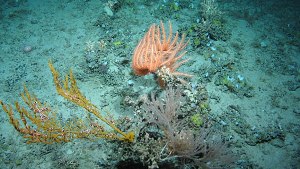Aug 6 2014
Heriot-Watt scientists have discovered new populations of deep-sea corals growing on the slopes of the UK’s highest underwater mountain, a site recently added to the list of Scotland’s new Marine Protected Areas.
UK’s highest underwater mountain
 Deep sea corals
Deep sea corals
Standing at 1400 m above the surrounding seafloor, the Hebrides Terrace Seamount is the UK’s highest underwater mountain (Beinn Nevis is 1344 m above sea level).
The deep-sea corals were discovered by a robot sub during the first-ever visual survey of the steep, sloping flanks of the Hebrides Terrace Seamount, an extinct, subsea volcano.
The corals support rich communities of other species and play a critical role in the life history of species that range far beyond the UK’s shores, such as threatened deep-sea skates which lay their eggs on them.
Researchers were surprised to find the corals growing at such depths, in seawater that is less hospitable than shallower water such as Rockall Bank where some of the best-known cold-water coral reef systems in the world are found.
At the seamount depths, the seawater is naturally more corrosive to coral skeletons and as ever- greater levels of carbon dioxide are released into the atmosphere, the oceans of the world are becoming more acidic.
Therefore the corals discovered during this survey may provide an important warning gauge of climate change, because they are already growing close to their limits.
If the water gets any more corrosive as the oceans become more acidic, then the parts of these deep-sea coral reefs that support so many other species will dissolve away.
The knock-on impact of ocean acidification on already-threatened and little known deep-water species such as the deep-water skate, could be catastrophic.
Marine Protected Areas
Because ocean ecosystems are under pressure from ocean acidification and other aspects of global climate change, Marine Protected Areas will become a vital way of conserving fragile ecosystems like those on the Hebrides Terrace Seamount.
The international survey team was led by Professor J Murray Roberts of the School of Life Sciences at Heriot-Watt University, aboard the RRS James Cook. Supplementary ship time funding for the Hebrides Terrace Seamount ROV survey was received from the Joint Nature Conservation Committee with the agreement of NERC.
Speaking about the discoveries made during the survey, Prof Roberts, Professor of Marine Biology, said “These were some of the most exciting surveys we’ve ever carried out at sea.
“We had spent almost a month at sea before we surveyed the Hebrides Terrace Seamount and it was so different from the other sites we examined.
“Now we need to get back to these sites to work out how these corals are able to survive in these harsh conditions.
“In the meantime it’s very promising to see this important place included as one of Scotland’s Marine Protected Areas.”
Their findings are reported in an academic paper: Henry, L.-A. Et al. Environmental variability and biodiversity of megabenthos on the Hebrides Terrace Seamount (Northeast Atlantic). Sci. Rep. 4, 5589; DOI:10.1038/srep05589 (2014) recently published online in Scientific Reports